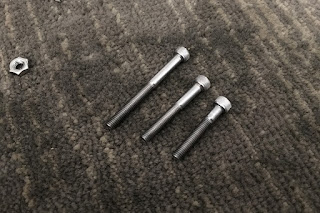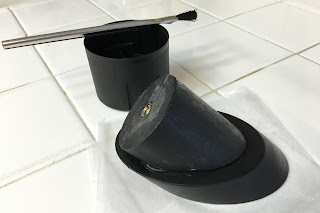I got a new secondary mirror from Antares Optics. The new mirror is a 2.6 minor axis, 1/18 wave PV.
The old mirror is a 2.48 minor axis and fits inside a casing that is part of the stock holder. The new mirror is too long and too wide to fit into the casing so I had to make a new holder.
I bought the 2" holder from Destiny but had to do some modifications to it to make it work in my scope.
I thought that the holder was plastic but it turns out to be cut from a 2" wooden dowel. If I had to do it again I would have just made my own from the start but anyway, here is how it went.
New holder next to the stock holder
First I had to take the long screw out of the holder. There was a wood plug that was pressure fit in to keep the screw from falling out. I used a long screw from the other side and a pair of pliers to pull it out and remove the screw.
The plug was then glued back in and drilled out to fit a brass wood insert nut. The holder will go back on to the spider and held in with a flat phillips screw. Much the same way as the stock holder.
Since the holder was too long I had to cut it shorter with a saw. If the holder was solid I could have cut it flat from the bottom but since I had to use the existing hole and plug to hold the insert nut I had to cut the 45 degree angle from the top end.
I'm using a safety cord to hold the mirror onto the holder just in case the silicone fails. I read about this on the internet forum boards. Better safe than sorry!
I drilled a hole into the side of the holder where I will slide a length of paracord (with the inside pulled out so it would sit flat on the back of the mirror). Now its ready for the mirror!
First, I cleaned the back of the mirror with alcohol. Then glued the safety cord to the back. I made a pattern of where the silicone blobs would be and used Zap A Gap CA+ to attach the cord to the back of the mirror between where the blobs would go. The tissue the mirror is sitting on is the same tissue that was used to ship the mirror. I don't know exactly what it is but if it was used by Antares then I'm sure it's safe.
After sitting for a day it was time to attach the holder. I put three blobs of black Aqueon Aquarium Sealant on the back of the mirror with toothpicks as spacers. I pulled some of the safety cord through the hole to take up some slack. Then carefully put the holder on pushing it down until it was against the toothpick spacers.
After letting it sit for 24 hours I pushed a piece of the toothpick into the hole with the paracord, cut it flat and put a little dab of Zap A Gap to keep it all in.
Here is the new holder and mirror compared to the stock.
I let it sit for another day and painted the back and sides of the mirror.
For this I used flat black spray paint that I sprayed into the lid and very carefully applied it to the mirror with a brush. I used a cheap brush I had and had to use a pair of scissors to trim the loose bristles. Next time i'll just buy a better brush.
The finished product ready for the scope!



































